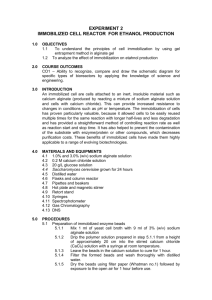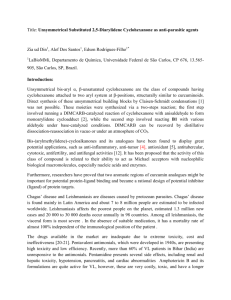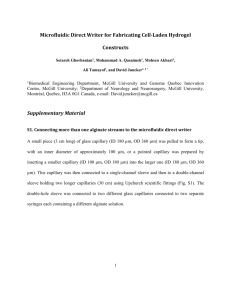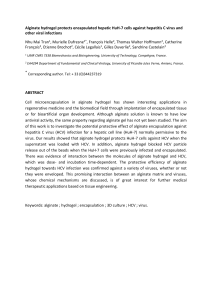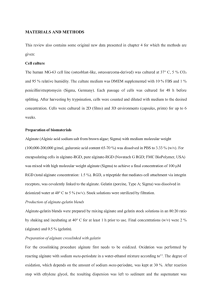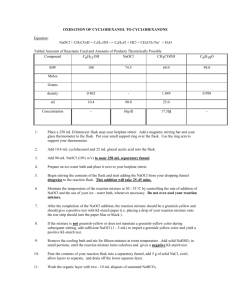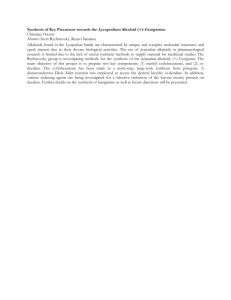immobization%20of%20yeasts%20new
advertisement
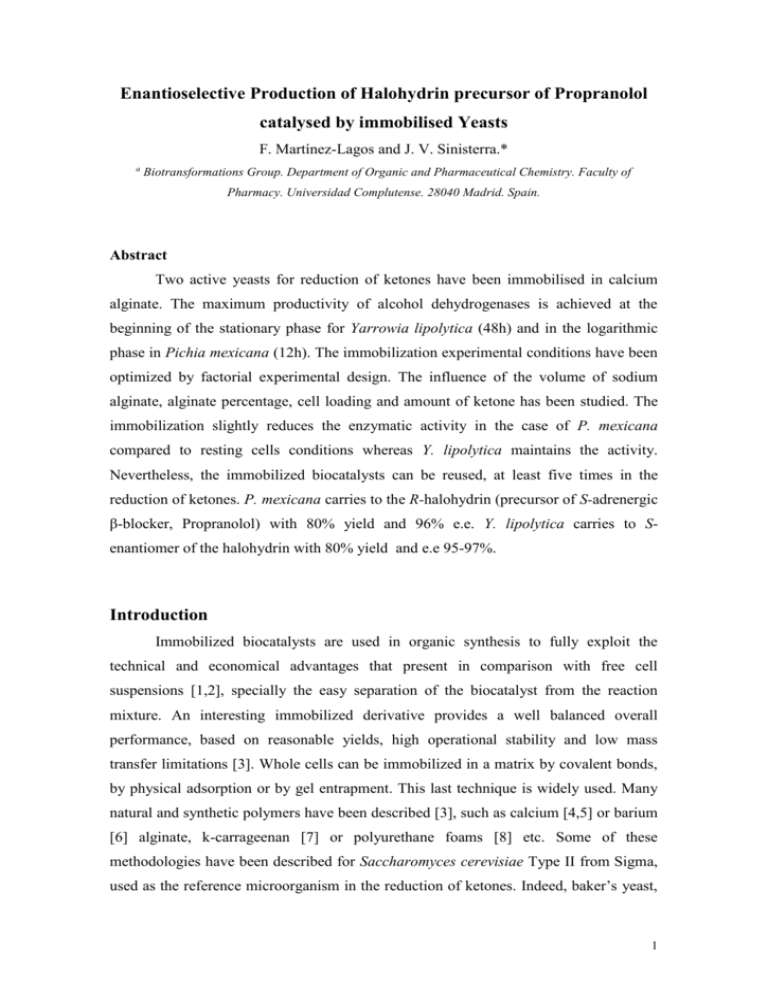
Enantioselective Production of Halohydrin precursor of Propranolol catalysed by immobilised Yeasts F. Martínez-Lagos and J. V. Sinisterra.* a Biotransformations Group. Department of Organic and Pharmaceutical Chemistry. Faculty of Pharmacy. Universidad Complutense. 28040 Madrid. Spain. Abstract Two active yeasts for reduction of ketones have been immobilised in calcium alginate. The maximum productivity of alcohol dehydrogenases is achieved at the beginning of the stationary phase for Yarrowia lipolytica (48h) and in the logarithmic phase in Pichia mexicana (12h). The immobilization experimental conditions have been optimized by factorial experimental design. The influence of the volume of sodium alginate, alginate percentage, cell loading and amount of ketone has been studied. The immobilization slightly reduces the enzymatic activity in the case of P. mexicana compared to resting cells conditions whereas Y. lipolytica maintains the activity. Nevertheless, the immobilized biocatalysts can be reused, at least five times in the reduction of ketones. P. mexicana carries to the R-halohydrin (precursor of S-adrenergic β-blocker, Propranolol) with 80% yield and 96% e.e. Y. lipolytica carries to Senantiomer of the halohydrin with 80% yield and e.e 95-97%. Introduction Immobilized biocatalysts are used in organic synthesis to fully exploit the technical and economical advantages that present in comparison with free cell suspensions [1,2], specially the easy separation of the biocatalyst from the reaction mixture. An interesting immobilized derivative provides a well balanced overall performance, based on reasonable yields, high operational stability and low mass transfer limitations [3]. Whole cells can be immobilized in a matrix by covalent bonds, by physical adsorption or by gel entrapment. This last technique is widely used. Many natural and synthetic polymers have been described [3], such as calcium [4,5] or barium [6] alginate, k-carrageenan [7] or polyurethane foams [8] etc. Some of these methodologies have been described for Saccharomyces cerevisiae Type II from Sigma, used as the reference microorganism in the reduction of ketones. Indeed, baker’s yeast, 1 immobilized in calcium alginate beads [9] or in polyamide foil [10] reduces more efficiently ketones than free cells. Chiral halohydrins have been widely used as building blocks to prepare blockers [11-15]. In this sense, the use of whole cells to catalyse the asymmetric reduction of haloketones such as 1, is a good procedure to obtain this intermediate for the preparation of S-adrenergic -blockers of Propranolol family (Scheme 1), [16,17]. + O Cl O 1 O O Cl Cl H OH HO H S-2 R-2 O NHiPr H OH S-blocker (drug) Scheme 1 Traditionally, in this process, the use of whole cells in Organic Chemistry laboratories has been limited until present to the well-known reduction of ketones to secondary alcohols using baker’s yeast [18-22]. Recently we have described two new fungi, Gongronella butleri [23] and Diplogelasinospora grovesii [24], and two new yeasts [25] as active strains for reduction of prochiral haloketones such as 1, under fermenter conditions [17,25,26]. Continuing with the studies initiated with free yeasts and fungi, the reduction of 1 was carried out using immobilized yeasts by means of calcium alginate entrapment. II-Materials and methods II.1. Yeast strains Saccharomyces cerevisiae (Baker’s yeast) Type II was purchased from Sigma. Yarrowia lipolytica CECT 1240 and Pichia mexicana CECT 11015 were supplied by Spanish Type Culture Collection (CECT; Valencia, Spain). The culture was controlled 2 using an Optical microscope Olimpus BH-2 coupled to a Panasonic camera WVCL310. II.2. Chemicals Cyclohexanone, cyclohexanol, saccharose and sodium alginate (analytical grade) were purchased to Sigma-Aldrich Chemical Company. The culture media components were supplied by Difco Laboratories and Merck, and the reagents were available from Sigma-Aldrich Chemical Company. 1-Chloro-3-(1-naphthyloxy)-2-propanone, 1, was synthesized as previously described [17]. II.3. Culture Conditions All the yeasts were grown at 28ºC. Culture medium (1L): glucose (10 g), peptone (3 g), yeast extract (3 g) and 0.1 M phosphate buffer (pH 7.0); for 48-72 h to the exponential phase. All the cultures were grown in 250 mL flasks containing 50 mL of medium, centrifuged and washed with sterile distilled water. II.4. Cells entrapment technique Yeast cells were entrapped within calcium alginate according to Sinisterra and Dalton [6]. Sodium alginate was added to distilled water and the mixture was stirred and sterilised at 120ºC for 15 min. Then, the cells were suspended in the solution of 100 mL of sodium alginate at 30-36ºC. The homogenous suspension was placed in a cylindrical reservoir and dropped through a syringe into a solution of 0.1 M CaCl 2. The formed spherical beads were rinsed with 0.1M CaCl2 solution (2 x 20 mL) and stored at 4ºC. The electronic microscopy analyses were performed in the Centre of Electronic Microscopy “Luis Bru” (Universidad Complutense de Madrid), using an electronic microscope JEOL, model JM-6400 of 40 Kv. The immobilized yeasts were fixed to calcium alginate with 25 mL of glutaraldehyde and dried with EtOH. II.5. Reduction of Cyclohexanone 5.1. Batch fermenting cells conditions e cells were cultured in the medium at 250 r.p.m and 28ºC in a Khüner shaker. After the appropriate culture time (see section III.1), 20 L of cyclohexanone (concentration of ketone =10 mM) were added to the culture flasks. The mixture was incubated on a rotatory shaker (Rotabit-Selecta, Barcelona, Spain) (160 rpm) at 28ºC. After incubation (48 h), the liquid was extracted with ethyl acetate (5 mL ethyl acetate/20 mL cell culture medium) [26]. The organic phase was analyzed using a Hewlett Packard Model 5890A GC: TR-WAX X capillary column (60 m x 0.25 mm x 0.25 m); To=155ºC (1 min) to 175ºC (6.5 min) at 4.0ºC min-1. Carrier gas (helium) 2.1 3 mL.min-1, split flow ratio 20:1. Using these conditions, the retention times of substrate and product were: Cyclohexanone= 4.36 min; Cyclohexanol = 4.83 min. The evaporation of cyclohexanone and cyclohexanol after 80hrs at 28ºC was lower than 5 ±1 % (G.C. external standard analysis). 5.2. Resting cells conditions The culture conditions were the same as described above. The cell culture broth was transferred to a falcon tube and centrifuged during 15 minutes time at 4,000 rpm. Then, the biomass was removed and washed three times using 20 mL of 50 mM phosphate buffer (pH 6.5), stirred in a vortex and the cells were removed from the liquid. When the cells were free from culture media they were resuspended using 20 mL of the same buffer in a 100 mL conical flask. 20 L (10 mM) of corresponding substrate and saccharose (600 mg) -as coenzyme regenerator- were added to the reaction media. After incubation (48 h), the aqueous phase was extracted with ethyl acetate (5 mL ethyl acetate/20 mL cell culture medium) for 5 min. The organic phase was dried and analyzed by GC as above. 5.3- Reduction of cyclohexanone by immobilized yeasts The reduction was carried out by the immobilized cells in a 100 mL flask containing 20 mL of Tris buffer 0.1 M (pH 7.0). A solution of cyclohexanone and 600 mg of saccharose were added. The reaction mixture was incubated in a rotatory shaker (160 rpm) at 28ºC for 48 h. The beads were then filtered and the remaining filtrate was extracted with ethyl acetate (5 mL). The mixture was centrifuged and decanted. Yields were determined by GC. II.6. Reduction of 1-Chloro-3-(1-naphthyloxy)-2-propanone, 1. 6.1. Resting cells conditions The general procedure was the same that above but a solution of ketone (0.2 g/L in 200 L of toluene) and 600 mg of saccharose were used [17]. After incubation (48 h), the aqueous phase was extracted with ethyl acetate (5 mL ethyl acetate/20 mL cell culture medium) for 5 min. The organic phase was analyzed by HPLC. The enantiomeric excess (e.e.) of the reaction product (1-chloro-3(1-naphthoxy)2-propanol) was determined by HPLC using a ConstaMetric 4100: chiral column (Chiracel OD), UV-vis detector, mobile phase was hexane/isopropanol/diethyl amine (70:30:0.1 (v/v/v)), flux 0.5 ml/min. Retention times: (R)-2 = 12.5 min; (S)-2 = 14.2 min; 1 = 10.1 min. Optical rotation was measured on a Perkin-Elmer 241 polarimeter 4 and the value and sign of the [] value were compared to those described in the literature [17]. Optical rotation for (R)-(2) (98% e.e): []D 25 = +9.9º (c= 0.5 g/100mL, EtOH) [23,24]. 6.2 Reduction of 1 by immobilized yeast The reduction was carried out using the calcium alginate biocatalyst prepared in the best conditions of immobilization obtained using cyclohexanone (Section III.2). The biocatalyst beads were introduced in a 100 mL flask containing 20 mL of 0.1 M Tris buffer (pH 7.0). A solution of 1 (0.2 g/L in toluene 200 l) and 640 mg of saccharose were added. The mixture was incubated on a rotatory shaker (160 rpm) at 28 ºC for 48 h. The beads were then filtered and the remaining filtrate was extracted with ethyl acetate (5 mL). The mixture was centrifuged and decanted. Yields and e.e. were determined by HPLC. II.7. Determination of the half life of the catalyst in the reduction of ketones. The bioconversions were carried out using the immobilised biocatalysts in 500 mL conical flasks containing 100 mL of 0.1 M Tris buffer (pH 7.0). The reaction conditions for cyclohexanone reduction and for the reduction of 1 were those described above. The mixture was incubated on a rotatory shaker (160 rpm) at 28 ºC for 48 h. The beads were then filtered and the remaining filtrate was extracted with ethyl acetate (25 mL). The mixture was centrifuged and decanted. Yields were determined by GC (cyclohexanone) or HPLC (1). After each reaction, the beads were rinsed with 0.1 M CaCl2 in 50 mL of buffer. This process was repeated twice. Then, the reduction process was repeated in the same experimental conditions. III. RESULTS III.1- Selection of active strains After a taxonomic screening of 416 strains, [25,26] four active yeasts for reduction of ketones were selected: Saccharomyces cerevisiae CECT 1317, Yarrowia lipolytica CECT 1240, Saccharomyces bayanus CECT 1969 and Pichia mexicana CECT 11015. Commercial Saccharomyces cerevisiae Type II from Sigma was used as the reference strain. 5 Y. lipolytica and P. mexicana showed the best activity in the reduction of cyclohexanone -screening reaction test [25]. In order to determine the fermentation time when the productivity of alcohol dehydrogenase (ADH) was in the maximum, the cells were grown and cyclohexanone (1g/L) was added at different fermentation times. Then, samples were analysed after 48 h contact time (Figure 1). The cells concentration of each culture broth was measured by the absorption at 660 nm using a calibration straight line [31]. The amount of cyclohexanol produced was determined by GC. Cyclohexanone was not transformed in biomass because the concentration of cells remained constant after the addition and the reduction of cyclohexanone. Figure 1. Production of biomass and yield in cyclohexanol. Y. lipolytica (a) and P. mexicana (b). Addition of 20 µL of cyclohexanone in 20 mL of reaction medium, at different growing times. Reaction time = 48 h. Yarrowia lipolytica CECT 1240 Pichia mexicana CECT 11015 The biomass production was very similar with both yeasts. The stationary state was achieved at 48 h of fermentation time, except in the case of the reference yeast, S. cerevisiae Type II (64 h fermentation-data not shown). The maximum yield in cyclohexanol was obtained when the ketone was added at 48 h, as for Y. lipolytica (Figure 1a), except in the case of P. mexicana (12 h) (Figure 1b). Therefore the highest production of alcohol is achieved at the beginning of stationary phase, except for P. mexicana for which it is achieved in the exponential growing zone. The maximum yields achieved were: Y. lipolytica CECT 1240 (43 %) P. mexicana CECT 11015 (22 %) Saccharomyces cerevisiae Type II from Sigma (8.2 % at 48 h). Cyclohexanone was not toxic for the strains at concentrations lower than 30µL/20mL medium. The 6 addition of cyclohexanone to the growing cells did not reduce the biomass produced. This concentration of cyclohexanone was greater than those described for the fungi G. butleri [23] and D. grovesii [24]. Therefore both yeasts are more resistant than those fungi to the chemical deactivation. III.2. Preparation of immobilized biocatalysts. The immobilization of the yeasts was performed in calcium alginate according to a previously described procedure [6]. The reduction of cyclohexanone to cyclohexanol was considered as the reaction test. In order to obtain the best immobilization conditions a factorial design of experiments was performed. The software package Statgraphics V.4 from Statiscal Graph. Corp. was used. Three variables that determine the physical and chemical properties of the beads of alginate were considered: i) alginate solution millilitres (Xa), ii) percentage of sodium alginate in the solution (Xb), iii) cells amount (Xc) plus the amount of added cyclohexanone (Xd). The maximum (+), minimum (-) and centre point (0) values are shown in the Table 1. The cells (Xc) of P. mexicana were harvested after 12 h fermentation time (Figure 1b) and Y. lipolytica whole cells were harvested after 48 h fermentation time (Figure 1a) to obtain cells with maximum activity in the reduction of ketones. Three response variables were selected: i) wet beads weight (g), ii) yield in cyclohexanol (%) and, iii) productivity of the reaction (% cyclohexanol/g wet beads). The obtained results are shown in Table 2 (P. mexicana) and Table 3 (Y. lipolytica). Table 1. Values of the variables used in the experimental design. a b () 0 (+) Xa (mL of alginate) 10 20 30 Xb (% of alginate)a 0.5 1.5 2.5 Xc(number of cells)b 1 2 3 Xd (L cyclohexanone) 10 20 30 % in weight number of erlenmeyers with 20 mL of culture medium used. 7 Table 2. Reduction of cyclohexanone with P. mexicana CECT 11015 immobilized on alginate. run Xa Xb Xc Xd Wet bead (g) Catalyst loading (x106 cell/g)a Cyclohexanol (%) Prod.b 1 2 3 4 5 6 7 8 9 10 20(0) 30(+) 10(-) 10(-) 30(+) 10(-) 30(+) 10(-) 30(+) 20(0) 1.5(0) 0.5(-) 0.5(-) 2.5(+) 2.5(+) 2.5(+) 2.5(+) 0.5(-) 0.5(-) 1.5(0) 2(0) 3(+) 1(-) 3(+) 1(-) 3(+) 1(-) 1(-) 3(+) 2(0) 20(0) 30(+) 30(+) 30(+) 30(+) 10(-) 10(-) 10(-) 10(-) 20(0) 8.69 7.49 2.66 5.17 16.67 4.97 13.76 1.93 6.01 8.80 299 520 488 754 78 261 94 673 649 295 33 36 27 39 24 52 30 38 59 38 3.8 4.8 10.0 7.5 1.4 10.5 2.2 20.0 9.8 4.3 Xa: mL alginate; Xb: % alginate; Xc: number of erlenmeyers with fermented cells used; Xd= L cyclohexanone. a cell loading (x106 cells/g wet beads). b productivity x103 (Cyclohexanol (%)/g wet beads). The concentration of cyclohexanol (mM) can be obtained from the amount of cyclohexanone added (Xc) (density = 0.9478 g/mL). Table 3. Reduction of cyclohexanone with Y. lipolytica CECT 1240 immobilized on alginate. run 1 2 3 4 5 6 7 8 9 10 Xa 20(0) 30(+) 10(-) 10(-) 30(+) 10(-) 30(+) 10(-) 30(+) 20(0) Xb Xc 1.5(0) 0.5(-) 0.5(-) 2.5(+) 2.5(+) 2.5(+) 2.5(+) 0.5(-) 0.5(-) 1.5(0) Xd 2(0) 3(+) 1(-) 3(+) 1(-) 3(+) 1(-) 1(-) 3(+) 2(0) Wet bead (g) 20(0) 30(+) 30(+) 30(+) 30(+) 10(-) 10(-) 10(-) 10(-) 20(0) Catalyst loading (x106 cell/g)a 9.70 6.70 2.24 5.75 15.13 6.36 12.72 1.96 6.22 9.42 293 636 634 740 94 670 112 724 685 301 Cyclohexanol (%) 56. 61 37 58 34 63 44 48 59 54 Prod.b 5.8 9.1 16.5 10. 2.3 9.9 3.45 24 9.5 5.7 Xa: mL alginate. Xb: % alginate. Xc: number of erlenmeyers with fermented cells used; Xd: L cyclohexanone. a cell loading (106 cells/g wet beads) b Productivity x 103 (Cyclohexanol(%)/g wet beads). The concentration of cyclohexanol (mM) can be obtained from the amount of cyclohexanone added (Xc) (density = 0.9478 g/ml) The best immobilisation conditions –according to the experimental design for Pichia mexicana (Table 2) and Y. lipolytica (Table 3)- to achieve the maximum productivity are obtained for run 8 (10 mL of alginate, 0.5 % of alginate, 1 erlenmeyer of cell culture broth (20 mL of culture medium) and 10 L cyclohexanone). 8 As previously described [25,26], resting cells conditions are better than fermenter conditions to transform cyclohexanone in cyclohexanol because the growing cell metabolism is stopped (table 4). Table 4. Yields of the reduction of cyclohexanone (%) in fermenter conditions, by resting cells and immobilized yeasts. Yeast Fermenter conditions (Fig.1) Resting cellsa Immobilized cellsb P. mexicana CECT 11015 22 (12 h) 77 38 Y. lipolytica CECT 1240 43 (48 h) 54 56 S. cerevisiae Type II 8 (48 h) 13 3 Resting cells conditions: 20 mL of culture medium. 20 L of ketone, 600 mg of saccharose and 20 mL 0.1 M phosphate buffer pH=7. Reaction time 48h. b Immobilization conditions: 10 mL of alginate solution of 0.5 % on weight, 1 erlenmeyer with 20 mL of culture medium, 10 L of ketone. Reaction time 48 h. a The immobilization reduces the enzymatic activity in the case of P. mexicana (the most sensitive to the toxicity of ketone), 38 % compared to resting cells conditions, 77%. The same behaviour was observed in the case of S. cerevisiae Type II (3% versus 13%). This result could be related to an increase in the micro environmental concentration of hydrophobic toxic molecules (cyclohexanone and cyclohexanol), produced by the presence of hydrophilic alginate matrix. Contrarily, in the case of Y. lipolytica CECT 1240 the activity is maintained (56% versus 54%) in accordance to the great resistance of this strain versus the toxicity of hydrophobic molecules [25,26]. Nevertheless, the immobilised whole cells can be reused as we show in Figure 2, improving the biotransformation procedure. III.3 Reduction of 1-Chloro-3-(1-naphthyloxy)-2-propanone, 1, by Immobilized yeasts. These strains were used in the reduction of the haloketone 1 to halohydrin 2 which carries out with (R)-Propranolol as intermediate key (table 5). 9 Table 5. Reduction of 1 using growing cells.a Microorganism Biomass b Y. lipolytica CECT 1240 P. mexicana CECT 11015 S. cerevisiae Type II 72 66 54 Yield c (%) 25 23 15 Prod.d Stereochemistry e 0.29 0.28 0.23 S>R R>S R>S e.e.c (%) 99 10 74 a [ketone]=0.19 mmol in 20mL of reaction volume x106 cells/mL c Molar yield in cyclohexanol (%) and e.e. determined by HPLC after 120 h reaction time d Productivity x 10-6 (mmol/(mL.h.106cell.)). e Stereochemistry according to the specific rotation values [14]. b The reduction of haloketone 1, was performed with good enantioselectivity in the case of Y. lipolytica. Unfortunately, the main stereoisomer is not useful to obtain the S-enantiomer, that is the active drug (Scheme 1). P. mexicana gave the interesting stereomer but with very low e.e. under fermenter conditions. Even S. cerevisiae gave a similar yield and greater e.e. than P. mexicana. To overcome these problems we performed the experiments using resting cells or immobilized whole cells in calcium alginate (Table 6). Table 6. Reduction of 1 using immobilized yeast in calcium alginate. Resting cellsa Immobilized cellsb yield (%)c/ e.e. (%)d yield (%)c/ e.e. (%)d S. cerevisiae Type II 30/83 (S)c 14/85 (S) P. mexicana CECT 11015 85/95 (R) 77/96 (R) Y. lipolytica CECT 1240 87/99 (S) 80/99 (S) Yeast a Resting cells conditions: 20 mL of culture medium. [ketone] =0.2 g/L, 200 µL of toluene, 600 mg of saccharose and 20 mL 0.1 M phosphate buffer pH=7. b Immobilization conditions (run 8, Tables 3 and 4). Reaction conditions= 0.2 g/L of ketone en 200 L of toluene, 600 mg of saccharose and 20 mL buffer Tris 0.1 M pH=7. Amount of biocatalyst: S. cerevisiae Type II 2.6 g beads (500x106 cells/g bead); P. mexicana 1.93 g beads (673x106 cells/g bead); Y. lipolytica 1.96 g beads (724x106 cells/g bead) c yields and e.e. were determined by chiral HPLC technique. d The absolute configuration was assigned on the basis of the specific rotation. S(+)-(99%) 25D= +9.3 (c=1.9 EtOH), R(-)-(95%) 25D= -8.8 (c=1.9 EtOH). We can observe that the physiological conditions dramatically affect the yield and the e.e. of the alcohol produced using baker’s yeast. Indeed, the immobilization or the use of resting cells reduces the yield in cyclohexanol compared to fermenter conditions for S. cerevisiae (Tables 5 and 6). Contrarily the non-fermenter conditions exert a very positive effect in the case of the new strains; giving high yields (75-85%) 10 and e.e (95-97%). These results are interesting because the R-alcohol (that leads to (S)Propranolol (Scheme1)) or the S-alcohol, that yields the opposite stereomer, can be both achieved with good e.e. and yield. Therefore this methodology is very interesting to prepare this adrenergic β-blocker drug family. It is better than that described using lipases for resolution of the halohydrin 2 [15], chiral stationary phase chromatography [29] or other fungi previously described in the research group for this reduction [23,24]. III.3- Reuse of the biocatalyst While resting cells cannot be reused, immobilized biocatalyst can carry out the reactions several cycles, as we show in Figure 2. This result indicates the convenience of the immobilisation-stabilisation of whole cells to perform the process. Figure 2. Number of cycles A) in the reduction of cyclohexanone with Pichia mexicana CECT 11015. 100% activity = 35% yield referred to initial cyclohexanone added. B) in the reduction of 1-Chloro-3-(1-naphthyloxy)-2-propanone with Yarrowia lipolytica CECT 1240. Both strains were immobilised in calcium alginate. 100% activity = 25% yield referred to ketone. A) Pichia mexicana CECT 11015 100 % yield 80 60 40 20 0 1 2 3 4 5 6 7 number of re-use B) 11 Yarowia lipolytica CECT 1240 100 % yield 80 60 40 20 0 1 2 3 4 5 6 7 number of re-use The graphics are similar in both strains and with both ketones (figure 2). After five cycles –equivalents to 240 h working–, the biocatalyst retained about 50% of its original activity, remaining the enantioselectivity. Finally, the diminution in the enzymatic activity should be related to the deactivation of intracellular enzymes or to the defectiveness in the coenzyme regeneration using saccharose, because the cells – apparently– remain unaltered after five cycles (Figure 3). Figure 3.- Electronic micrographs of Y. lipolytica (x 1,000) immobilized in calcium alginate (A), and after 5 cycles (x 6,000) (B). a) b) ACKNOWLEDGEMENTS 12 This paper has been supported by the grants BIO2000- 0747-C05-01 and BQU 2001-1301, from Ministerio de Ciencia y Tecnología of Spain. The authors gratefully acknowledge the collaboration of Mr. Velazquez (Universidad Tijuana, Mexico) in the experimental work. References [1] M.B. Angelova, S.B. Pashova, C. Slokoska, Enzyme Microb. Technol. 26 (2000) 544. [2] W. Tischer, F. Wedekind, in Fessner H.D. (Ed.) Immobilized enzymes: Methods and Applications. Biocatalysis. Topics in Current Chemistry, 1999, pp. 95-126. [3] R.H. Wijffels, R.M. Buitelaar, C. Bucke, J. Tramper, Immobilized cells: Basics & Applications. Progress in Biotechnology, Editorial Elsevier, Amsterdam, 1996, Volume 11. [4] (a) T. Haag, T. Arslan, D. Seebach,. Chimia 43 (1989) 351; (b) F. Molinari, C. Bertolini F. Aragozzini, Biocatalysis and Biotransformations 16 (1997) 87. [5] K. Nakamura, Y. Kawai, A. Ohno, Tetrahedron Letters 31 (1990) 267. [6] J.V. Sinisterra, H Dalton, in R.H. Wijffels, R.M. Buitelarr; C. Bucke and J.Tramper. (Eds), Influence of the immobilization methodology in the stability and activity of P.putida UV4 immobilized whole cells. Immobilized cells: Basic & Applications. Elsevier Science B.V., 1996, pp.416-423. [7] T. Kometani, E. Kitatsuji, R. Matsuno, Chem. Lett. (1989) 1465. [8] K. Nakamura, K. Inoue, K. Ushio, S. Oka, A. Ohno, J. Org. Chem. 53 (1988) 2589. [9] J. Howarth, P. Janes, J. Dai. Tetrahedron Lett. 42 (2001) 7517. [10] K.D. Green, I. S. Gill, J.A. Khan, E.N. Vulfson, Biotechnol.Bioeng 49 (1996) 1. [11] R. MacLeod, R ., H. Prosser, L. Fikentscher, J. Lanyi, H.S. Mosher, Biochemistry 3 (1964) 838. [12] O. Cervinca, L. Hub, Collect. Czech. Chem. Commun. 31 (1966) 2615. [13] K. Otsuka, Sh. Aono, I. Okura, F. Hasumi,. J. Mol. Catal. 51 (1989) 35. [14] A. Sutherland, Ch. L. Willis, J. Org. Chem. 63 (1995) 7764. [15] J.L. Bermúdez, C. Del Campo, L. Salazar, E.F. Llama, J.V. Sinisterra. Tetrahedron: Asymmetry 7 (1996) 2485. [16] (a) R. Csuk, B.I. Glanzer, Chem. Rev. 91 (1991) 49 (b) E. Santaniello, P. Ferraboschi, P. Grisenti, A. Manzocchi, Chem. Rev. 92 (1992) 1071. (c) J.R. Hunt, A.S. Carter, J.C. Murrell, H. Dalton, K.O. Hallinan, D.H.G. Crout, R.A. Holt, J. Crosby, Biocatalysis Biotransformations 12 (1995) 159. [17] F. Martínez, C. Del Campo, E.F. Llama, J.V. Sinisterra. Tetrahedron: Asymmetry 11 (2000) 4651. [18] K. Nakamura, Y. Kawai, N. Nakajima, A.Ohno. J. Org.Chem. 56 (1991) 4778. [19] J. Heidlas, K-H Engel, R. Tressi, Enzyme Microb.Technol. 13 (1991) 817. 13 [20] G. Egri, A. Kolbert, J. Balint, E. Fogassy, L. Novák, L. Poppe. Tetrahedron: Asymmetry 9 (2000) (1998) 271. [21] Ch.J. Sih, Ch.Sh. Chen, Angew. Chem. Int. Ed. Engl. 23 (1984) 570. [22] I.A. Kaluzna, T. Matsuda, A.K. Sewall, J.D. Stewart. J.Am.Chem.Soc. 126 (2004) 12827. [23] J.D. Carballeira, M. Valmaseda, E. Alvarez, J.V. Sinisterra, Enzyme Microb. Technol. 34 (2000) (2004), 611. [24] J.D. Carballeira, E. Alvarez, M. Campillo, L. Pardo, J.V. Sinisterra, Tetrahedron Asymmetry 15 (2004) 951. [25] F. Martínez Lagos, J.D. Carballeira, J.L. Bermúdez, E. Alvarez, J.V. Sinisterra, Tetrahedron: Asymmetry 15 (2004) 763. [26] J.D. Carballeira –Ph.D. Thesis, Universidad Complutense, Madrid, July 2003. [27] S. Svensson, J.O. Höög, G.Y. Schneider T. Sandalova, J.Mol.Biol. 302 (2000) 441. [28] The growing curves of cells were determined using a absorbance curve (= 600 nm) in a UV-Vis Cecil 1021 spectrometer. The calibration straight line was: Abs (D.O.)= 0.0883Ccuv(106 cel/mL) + 0.0183 N= 10 R= 0.998 t=38.77 F1,7 (0.05)= 5.59 The curve was obtained using S. cerevissiae Type II culture. The number of cells were determined using a Neubauer camera (0.0025 mm2 and 0.100 mm deep). [29] C. Del Campo, E.F. Llama, J.L. Bermúdez, J.V. Sinisterra, Biocatalysis Biotransformations 19 (2001) 163. 14
